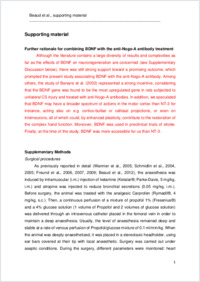Combined with anti‐Nogo‐A antibody treatment, BDNF did not compensate the extra deleterious motor effect caused by large size cervical cord hemisection in adult macaques
- Beaud, Marie-Laure Department of Neurosciences and Movement Sciences, Faculty of Sciences and Medicine, University of Fribourg, Switzerland
- Rouiller, Eric M. Department of Neurosciences and Movement Sciences, Faculty of Sciences and Medicine, University of Fribourg, Switzerland
- Bloch, Jocelyne Department of Neurosurgery, Neurosurgery Clinic, University Hospital of Lausanne, Switzerland
- Mir, Anis Neuroscience Research, Novartis Institute for BioMedical Research, Basel, Switzerland
- Schwab, Martin E. Brain Research Institute, University of Zürich, Switzerland - Department of Biology, ETH Zurich, Switzerland
- Schmidlin, Eric Department of Neurosciences and Movement Sciences, Faculty of Sciences and Medicine, University of Fribourg, Switzerland
-
16.08.2019
Published in:
- CNS Neuroscience & Therapeutics. - 2019, p. cns.13213
English
In spinal cord injured adult mammals, neutralizing the neurite growth inhibitor Nogo‐A with antibodies promotes axonal regeneration and functional recovery, although axonal regeneration is limited in length. Neurotrophic factors such as BDNF stimulate neurite outgrowth and protect axotomized neurons. Can the effects obtained by neutralizing Nogo‐A, inducing an environment favorable for axonal sprouting, be strengthened by adding BDNF? A unilateral incomplete hemicord lesion at C7 level interrupted the main corticospinal component in three groups of adult macaque monkeys: control monkeys (n = 6), anti‐Nogo‐A antibody‐treated monkeys (n = 7), and anti‐Nogo‐A antibody and BDNF‐treated monkeys (n = 5). The functional recovery of manual dexterity was significantly different between the 3 groups of monkeys, the lowest in the control group. Whereas the anti‐Nogo‐A antibody‐treated animals returned to manual dexterity performances close to prelesion ones, irrespective of lesion size, both the control and the anti‐Nogo‐A/BDNF animals presented a limited functional recovery. In the control group, the limited spontaneous functional recovery depended on lesion size, a dependence absent in the combined treatment group (anti‐Nogo‐A antibody and BDNF). The functional recovery in the latter group was significantly lower than in anti‐Nogo‐A antibody‐treated monkeys, although the lesion was larger in three out of the five monkeys in the combined treatment group.
- Faculty
- Faculté des sciences et de médecine
- Department
- Département de Médecine
- Language
-
- English
- Classification
- Biological sciences
- License
-
License undefined
- Identifiers
-
- RERO DOC 327442
- DOI 10.1111/cns.13213
- Persistent URL
- https://folia.unifr.ch/unifr/documents/308170
Other files
Statistics
Document views: 139
File downloads:
- pdf: 147
- Supplementary material: 127

